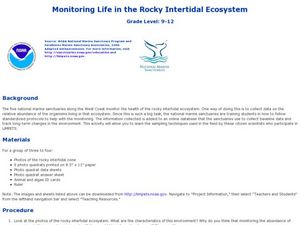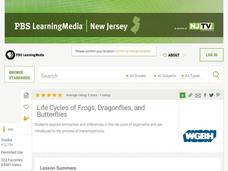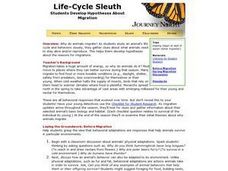Curated OER
Life Cycle Of Stars
Students analyze characteristics that indicate human life cycles, and then apply these observational principles to various NASA pictures of stars to synthesize patterns of stellar life cycles. They observe NASA images of stars at various...
Curated OER
Monitoring Life In The Rocky Intertidal Ecosystem
Students investigate marine life by researching aquatic organisms on the Internet. In this oceanography instructional activity, students monitor algae and animals of the ocean by identifying their population and habitat on data sheet ID...
Curated OER
Working with Half-Life
In this half-life worksheet, students use a given table of half lives, mass, time and amount of original sample to solve for unknowns in nine given half-life problems.
Curated OER
Arthropod Life Cycle
In this arthropod life cycle worksheet, students will use a diagram showing the 4 stages of butterfly metamorphosis to complete a table describing each of the stages.
Curated OER
Pollution and Marine Life
In this pollution and marine life worksheet, learners use 9 given terms related to types of pollution and ocean food chains to complete sentences. Students number the effects of human sewage and soil runoff that harm ocean organisms in...
Curated OER
Life Cycles of Frogs, Dragonflies, And Butterflies
Students explain the similarities and differences in the life cycles of organisms. The lesson plan begins with a reading of Eric Carle's The Very Hungry Caterpillar.
Curated OER
Life-Cycle Sleuth
Students analyze an animal's life cycle and behaviors, and examine what animals need to stay alive and reproduce. They develop theories and hypotheses about the reasons for migrations, using the Journey North online project.
Curated OER
African Americans in Science
Students explore the careers of prominent African Americans in science, mathematics, and technology. They use The Faces of Science: African Americans in the Sciences website, which includes profiles of past and present African Americans...
Curated OER
Science Current Events Lessons
You can use current events to increase student understanding of both science concepts and language arts skills.
Curated OER
Applying Science
In this applying science worksheet, students are given 8 scrambled words to complete sentences about technology, machines and robots. Students answer 6 questions about the effects of technology on life span and the use of robots and...
Curated OER
GED: Vocabulary: Life Science
In this GED vocabulary worksheet, students complete a crossword puzzle given 10 clues about genetics and cloning, food chains, vaccines, the brain and the nervous system and organisms. Students are given a word bank to use to complete...
Curated OER
Structure and Function of Vertebrates - Reading/Notetaking Guide - Amphibians
A variety of questions are presented on the amazing amphibian. Life science intellectuals complete a life cycle diagram, describe characteristics and behaviors, and fill in a metamorphosis flowchart. Content level is geared toward middle...
Curated OER
Introducing Evolution
The intent of this slide show is to introduce young biologists to evolution, specifically how populations change through time. The content does not support the stated objective. What you will find in this presentation is general...
Virginia Department of Education
Cell Parts
What do a bird, an egg, a rabbit, and a toad all have in common? This fun-filled resource explains the similarities and differences between cells and how all cells are similar, yet all are different. Learners begin by depicting a...
California Academy of Science
Color Vision Genetics Evolution Simulation
At one point, all mammals carried only two color receptors, but now most humans carry three. An informative presentation and hands-on activity demonstrate how this evolved through genetics. By participating in the activity, pupils...
Core Knowledge Foundation
Cycles in Nature Tell It Again!™ Read-Aloud Anthology
A read-aloud anthology offers stories all about nature's life cycles. Over three weeks, second graders listen to and discuss tales about the cycles of daytime, nighttime, seasons, plants, trees, frogs, butterflies, and water. Following...
Curated OER
Out and About: The Science of Sport
Students take a closer look at sports science. In this hands-on learning lesson, students may visit the Science Museum, the Life Science Centre, or the Wimbledon Lawn Tennis Museum online or in-person to discover details related to the...
Curated OER
The Life Cycle of the Butterfly
Second graders study the life cycle of a butterfly by observing metamorphosis taking place in a butterfly pavilion. Students illustrate their understandings of the body parts of a caterpillar and butterfly, as well as the life cycle,...
Curated OER
Life Cycle Literature Briefs
Literature containing life cycle information is available from many sources. Several examples of this type of literature are listed below with a synopsis and sample questions for each. These examples have been taken from a variety of...
Curated OER
Life Science Animal Worksheet: Mammals
In this animal classification practice worksheet, students examine the 6 pictured animals and identify the animals that are mammals.
Curated OER
Discovery Science Center Activities
Fourth graders complete a variety of experiments to meet science goals. In this life sciences lesson plan, 4th graders make yogurt, discover the attraction of opposite charges in electricity, learn the effects of glaciers, and...
Curated OER
Cell Biology
Identify the different cell organelles in prokaryotes. Modelling the cells using Jell-o and candies will be a fun way to experience the cell in a hands-on way (different to using play-doh!). They observe cells under a microscope and draw...
Kenan Fellows
The Effects of Environmental Conditions on Aquatic Organisms
What kind of experiment can your class do to how observe the environment effects on organisms? Groups design and conduct lab experiments to learn about the effects of the environment on aquatic organisms. Based upon knowledge gained...























